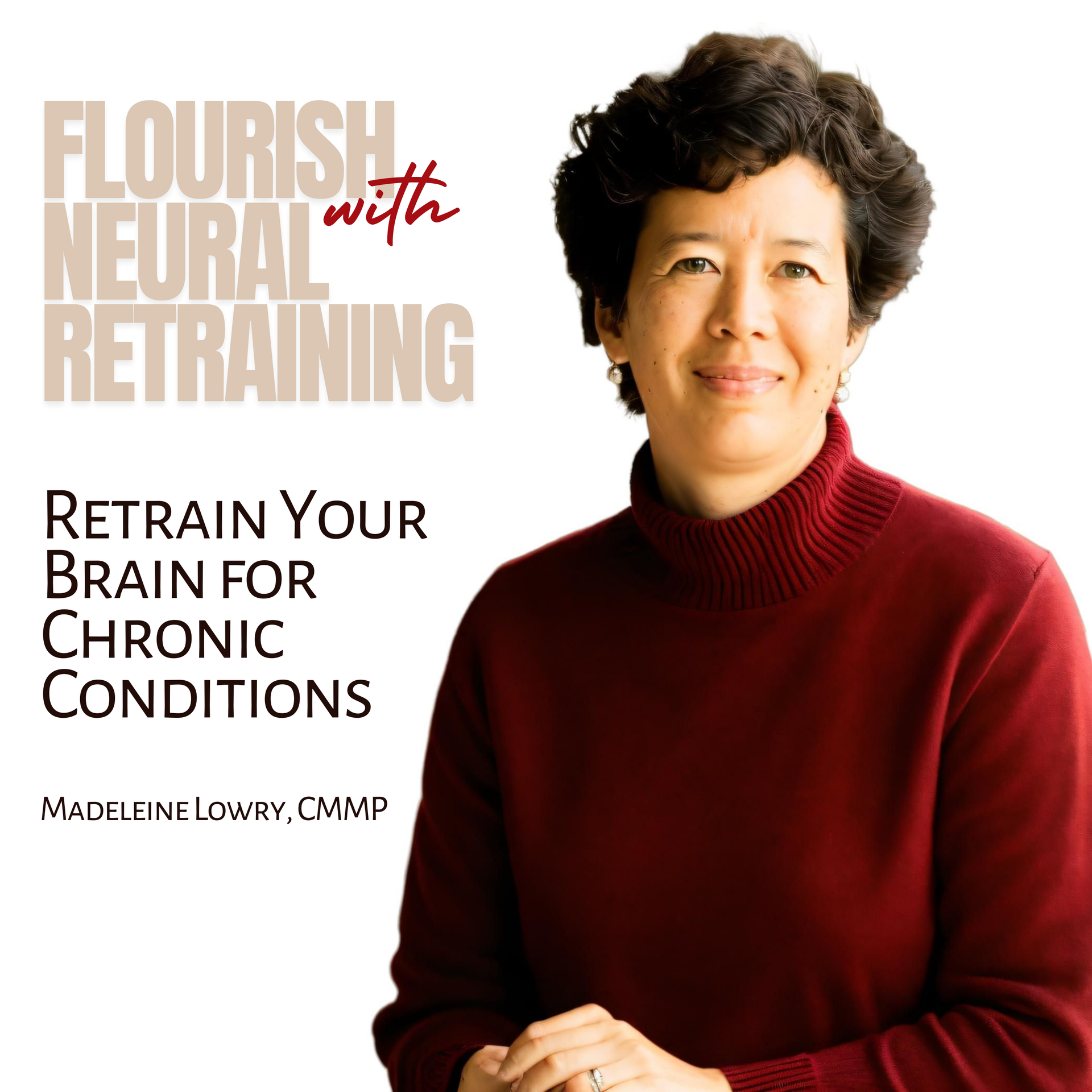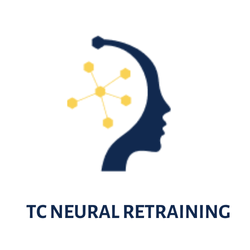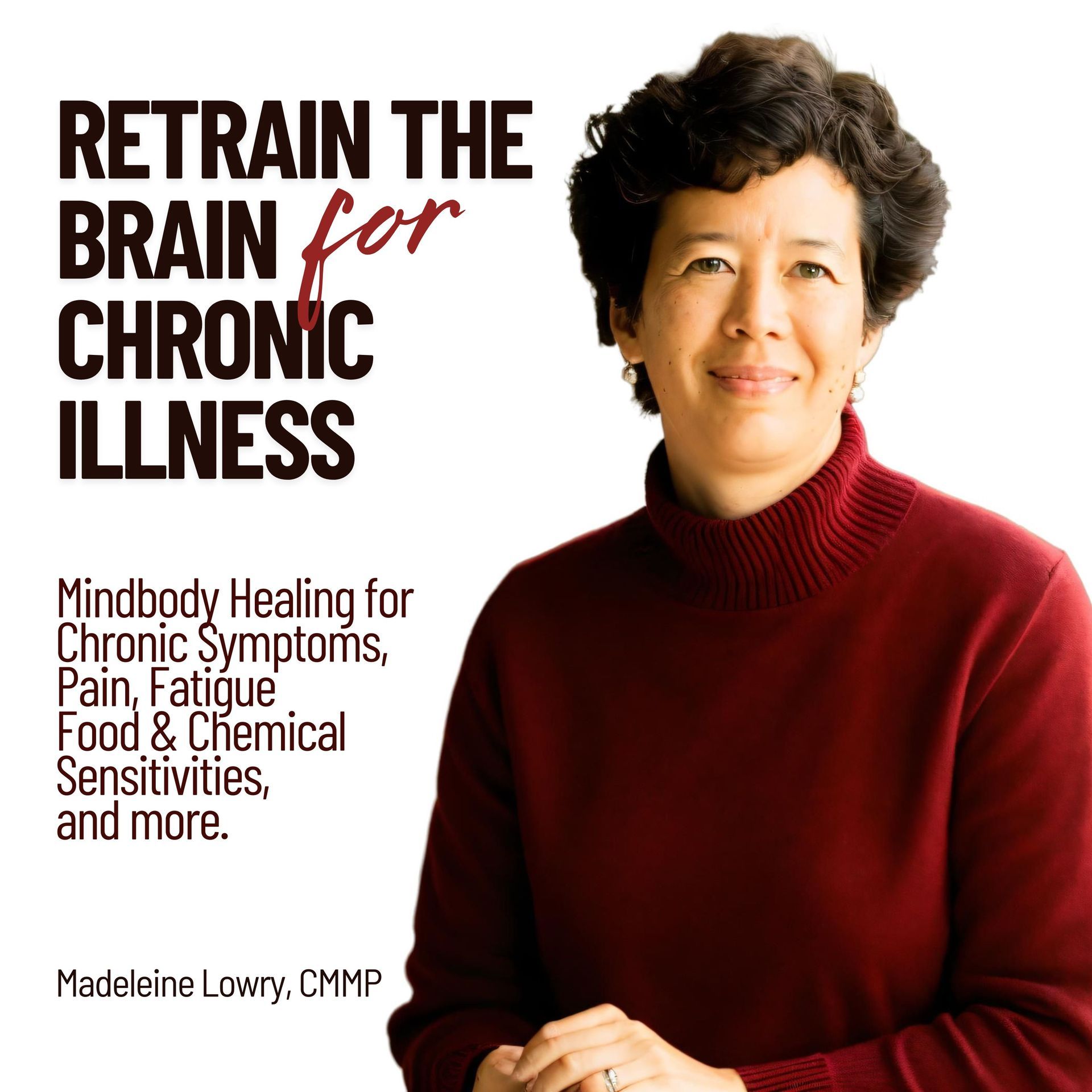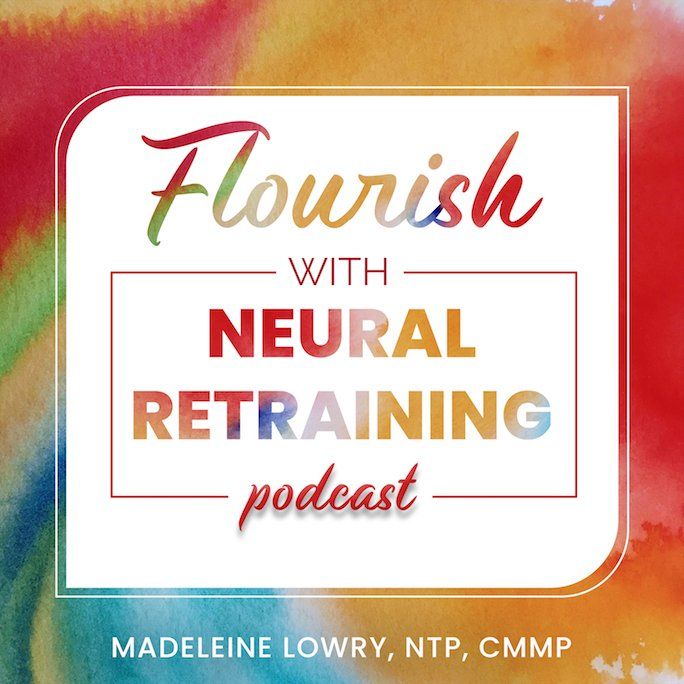Mindbody Healing 2.0: Beyond the Sarno Method with Advanced Neural Retraining for Chronic Pain and Symptoms
Flourish with Neural Retraining Podcast, Episode 82 - A Listener's Guide

Listen to the podcast episode
In This Episode
- Learn about Dr. Sarno's contribution to mindbody medicine and how his method helped thousands of people with chronic pain.
- Why the Sarno Method is not enough for some people and how to go deeper and get results faster by working with the subconscious mind.
- How personality traits, painful emotional experiences and high emotional sensitivity can contribute to chronic pain and symptoms, and what to do about it.
Show Notes
In this episode of Flourish with Neural Retraining, host Madeleine Lowry explores how we can go beyond the pioneering work of Dr. John Sarno—renowned for his groundbreaking TMS (Tension Myoneural Syndrome) mindbody approach—to achieve lasting relief from chronic pain, chronic symptoms, and unresolved emotional stress.
While Sarno’s method revolutionized how we understand the connection between repressed emotions and physical illness, Madeleine shares how the MAP Method of advanced neural retraining builds on his insights to reach deeper layers of healing.
You’ll learn:
- The foundations of Dr. Sarno’s TMS theory and why it helped so many people.
- The personality traits (perfectionism, people-pleasing, goodism) often linked to chronic pain.
- Why unresolved trauma and suppressed emotions create chronic symptoms.
- How MAP neural retraining works with the subconscious mind to resolve emotional stress patterns.
- Key differences between Sarno’s education-based approach and the MAP method’s direct subconscious reprogramming.
If you’ve tried Sarno’s work but still struggle with symptoms—or if you’re curious about rewiring your subconscious for emotional and physical healing—this episode will give you a fresh perspective and a clear path forward.
🌐 Learn more at TCNeuralRetraining.com
🎧 Subscribe and leave a review on Apple, Spotify, or your favorite podcast platform.
Full Transcript
Note: generated by AI, accuracy not guaranteed.
(Intro Music)
Welcome to the Flourish with Neural Retraining podcast. I'm your host, Madeleine Lowry, a neural retraining specialist. And today we are going to talk about going beyond the Sarno method to address chronic pain, chronic symptoms and conditions with an advanced neural retraining method known as MAP for lasting healing. My goal here is to share insights that I have gathered through my own experience and years in practice, helping you to understand not just what might be causing your chronic issues, but how you can find a path forward.
We begin by acknowledging the profound contributions of Dr. John Sarno, a pioneer who spent 50 years at NYU's Rusk Institute for Rehabilitative Medicine, laying critical groundwork for understanding the mindbody connection in chronic illness. He specialized in chronic back pain and over his long career, he authored four influential books. While his work was groundbreaking, many of us, including myself, have found the need to go even further for lasting resolution. I will share how my practice utilizing the advanced neural retraining method known as MAP builds upon Sarno's critical insights to provide a more efficient and comprehensive path to healing.
When Dr. Sarno first started his practice, he was trained in conventional western medicine. And for the first 8 to 10 years, he utilized the standard tools of the time, physical therapy, medications, and surgery to treat chronic back pain. However, he found himself increasingly dissatisfied with the results he was seeing. This dissatisfaction led him to reflect on something he had been taught in medical school which he attended sometime around the 1950s. At that time, medical school curricula still included teachings about the psychosomatic root causes or contributors to illness. He observed that this particular aspect of medical education later faded out largely due to the growing influence of the pharmaceutical industry and its focus on chemical solutions. Dr. Sarno therefore caught the tail end of an era where the profound connection between our emotions, our thoughts, and our physical health was still a standard part of medical training. Armed with this understanding, he began to introduce these ideas to his patients.
Fundamentally changing his approach to treatment. What he discovered was remarkable. This new approach yielded much greater success than the strictly medical methods he had previously employed. So, how did Dr. Sarno implement this? When patients would come to him with their scans and test results, he would sit with them and patiently explain what he termed normal abnormalities. This was a crucial point. He observed that many people with chronic back pain had certain abnormalities on their scans, but an equal number of people with those very same abnormalities experienced no pain at all. This led him to theorize that the pain his chronic sufferers were experiencing couldn't necessarily be attributed to those structural abnormalities, thus opening the door to a completely different way of understanding and approaching the problem.
Beyond individual consultations, he gave lectures where he educated them on how their thoughts, emotions, and in particular their repressed emotions, the emotions they weren't consciously aware of, could directly impact their physical experience and create pain. Dr. Sarno's work began with back pain, but he gradually broadened his scope after his first book on back pain. He started writing about pain syndromes in general and then expanded further to include all kinds of chronic conditions.
He began to generalize his theory under the umbrella term TMS which initially stood for tension myositis syndrome. Over time he renamed it to tension myoneural syndrome and by his last book he simply called it the mindbody syndrome. This evolution terminology itself reflects his deepening understanding of the broad scope of this phenomenon. At its core, Sarno's theory posited that various forms of chronic pain, including back pain, neck pain, fibromyalgia, and other pain syndromes, were not always caused by structural abnormalities, or unhealed physical injuries. Instead, he theorized that TMS pain originated from emotional and psychological factors, in particular, repressed emotions, inner conflicts, and stress. He believed there was a strong and direct link between our emotions and our physical health. His central idea was this.
When we repress a significant amount of painful emotions, we can manage to keep them buried for a while, perhaps for years or even decades, but eventually this buildup reaches a point where it starts to overflow. We simply can't stuff it down anymore. And at this critical juncture, the brain, in an effort to distract us from the truths we are unwilling to face, creates pain. According to Dr. Sarno's TMS theory, this is the origin of the pain. He firmly believed the pain was real. It was not all in your head in the dismissive sense. He explained that this very real physical pain was caused by mild oxygen deprivation in the muscles, which is why he initially named it tension myositis syndrome. This tension held in the muscles, nerves, and tendons generated genuine physical discomfort, but it was the result of repressed emotions rather than something inherently physically wrong with the body in a structural sense.
Interestingly, Dr. Sarno observed that TMS was not seen in the general population. He identified a common pattern amongst his patients, a specific personality type that seemed prone to developing TMS. He felt that individuals who tended to develop TMS often shared certain traits. They were high achieving. These were people driven to excel in school, their careers, relationships or other areas of life. They were perfectionists. These were individuals who strived for a flawless image or flawless results. These were people pleasers, people who prioritize making other people happy, often at their own expense. They also might have a strong sense of responsibility or what I like to call over responsibility and they may have a deep need for others to perceive them as good. A trait that he termed goodists. Now, it isn't necessary to have all of these traits. One or more of these traits is usually seen in people that tend to develop TMS.
So, why do these traits link to TMS? Dr. Sarno theorized that people who are driven to be high achieving, Perfectionistic or goodists often have to suppress their own frustrations, their own needs, and their own feelings in order to maintain this outward front or image to the world. If you think about it, I mean, who wants to be a perfectionist or a goodist all of the time? It's simply not fun. That inner desire for instant gratification and playfulness often gets repressed or denied as we toil away at tasks that may not yield immediate results. And this constant suppression creates a reservoir of negative emotions.
Another fundamental concept of TMS is the symptom imperative. Dr. Sarno saw this as the brain's ongoing need to create symptom after symptom to maintain its distraction strategy from the emotions we are unwilling to recognize or feel. For example, if someone had shoulder pain, if this was their initial PMS symptom and it was resolved through surgery, physical therapy or maybe a cortisone shot, the underlying emotional reservoir which hadn't been addressed would still be there and the brain would simply create another symptom to continue with its strategy of distraction. This could manifest as pain in another joint, a neuropathy or another type of chronic condition. Dr. Sarno's point was that symptoms could shift and move around, constantly keeping us distracted from the crucial emotions we need to face.
Dr. Sarno's treatment was primarily about information and education. Whether patients attended his lectures, watched his videos, or read his books, the core of the therapy was this transfer of knowledge about the mindbody connection. He empowered individuals with the understanding that their pain was real but rooted in emotional rather than purely structural issues.
His approach included a journaling method. He recommended that patients make three lists and engage in a daily journaling practice. List one was about childhood experiences and past traumas. List two was about current life stress and list three was about personality traits, particularly those traits like perfectionism or people pleasing that Dr. Sarno believed predisposed individuals to TMS. His instructions were simple. Each day, pick one topic from one of these lists and start writing about it. The key was to write down how you really felt with an eye towards uncovering deeper levels of emotion. He particularly felt that anger and rage were often the real driving forces behind pain syndromes, especially for those perfectionists and goodists who had to suppress immense frustration and irritation.
Dr. Sarno's influence was profound. He helped tens of thousands of people and his ideas made a significant impact in the world. Many individuals benefited greatly simply by reading his books, even if they never saw him in person.
So, let's talk about moving beyond Sarno. While Dr. Sarno laid critical groundwork, I've had the privilege of seeing how we can expand upon his foundational insights. In my practice, where I utilize an advanced method of neural retraining called MAP, we build on this mindbody understanding, taking it to a new level of efficiency and depth.
I want to be clear that comparing Dr. Sarno's method to the MAP method is not exactly an apples-to-apples comparison. Dr. Sarno developed his methods specifically for chronic pain and chronic pain syndromes and then chronic conditions. The MAP method on the other hand is a technique for advanced neural retraining that works directly with the subconscious mind. It was not developed specifically as a method for pain or chronic condition resolution. Rather, it is a powerful emotional release technique and a trauma healing technique that helps us get to the roots of many patterns held in the subconscious mind allowing us to either neutralize or change them.
However, if you understood Dr. Sarno's insights about the true roots of pain syndromes and chronic conditions and how they are deeply connected to our thoughts, our emotions, our personality, and our habitual responses to stress, then you can see how an advanced neural retraining method that addresses the emotional, mental, and behavioral levels could have a profound impact on physical health and this is where my work comes in.
While not all MAP practitioners specialize in chronic pain, some of us like myself have honed our expertise in this area. My own professional background led me to this path. I began as a nutritional therapy practitioner where I use diet, supplements, and lifestyle changes to assist people with chronic health issues. My practice also involved testing for various sensitivities to foods, to chemicals and other things. And what I consistently heard from my clients was a desire to eliminate these sensitivities rather than just avoid these substances or change their diets.
They wanted freedom and this led me to explore sensitivity elimination techniques. I learned several and the most promising one involved retraining the brain. It was a basic neural retraining method that required significant repetition of scripts, visualizations, and affirmations for an hour a day for many months and even years. While it did work for many, it didn't work for everyone, leaving about 25 to 30% of the people still struggling. This drove me to seek out something more effective.
And that is when I discovered this advanced method of neural retraining, the MAP method. I quickly realized that this advanced method, which works directly with the subconscious mind, could help people get unstuck from a much wider array of chronic health issues and symptoms, not just sensitivities. It is a meditative method requiring clients to be relaxed with their eyes closed, breathing slowly, deeply, and gently during sessions.
My practice has evolved with my primary focus now on individuals grappling with chronic health issues, chronic symptoms, chronic pain, chronic fatigue, and sensitivities as well as anxiety. Anxiety is a crucial component as it often accompanies other chronic conditions. I work with clients around the globe offering sessions over Zoom. These can be one-on-one sessions, group sessions led by a practitioner, or self-directed sessions using recorded programs. And often these different methods are used in combination. For example, some of my clients engage in one-on-one sessions with me every few weeks while also utilizing a pre-recorded program at home.
So, let me describe a little bit about my perspective on these issues versus Sarno's theories. I think we agree on several major points. I wholeheartedly agree with Dr. Sarno that psychological factors underlie all chronic conditions. Repressed emotions, inner conflicts, and stress are, in my experience, frequently the root causes and the perpetuating factors of pain, symptoms, or conditions. Dr. Sarno's regard for pain as a distraction is a little different from my perception. This is where my direct work with clients in one-on-one sessions has given me a slightly different perspective.
Having had the privilege of working with individuals one-on-one, observing sensations like tingling, tightness, or pain arise and then diminish or resolve in a session. It leads me to a different conclusion. I don't see the pain so much as a distractor. I see it more as a signal. This is your mind body bringing something important to your attention and letting you know that there's an unresolved issue that needs to be addressed.
Regardless of whether you see it as a distraction or a signal, as I do, the ultimate solution remains the same. It's about recognizing those repressed emotions, healing past trauma, and changing your response to stress. Dr. Sarno felt that anger and rage were often at the root of pain. And while they certainly can be, my experience shows that any negative emotion can play a role, not just anger and rage.
Dr. Sarno believed that certain personality traits make a person more prone to suppressing emotions, and I agree with that. He highlighted the goodist and the perfectionist, but I have found that this extends to many more types, such as the people pleaser, the caretaker, the fixer, the savior, the chameleon, and many more. All of these commonly recognized personality traits require us to deny or suppress our own emotions, our own needs and wants in service of others. And these habitual behaviors and responses create the perfect conditions for developing chronic symptoms and conditions.
Now, one aspect where my work goes beyond Dr. Sarnos is in the area of trauma, the crucial role of trauma. Dr. Sarno didn't extensively discuss this, but in my practice using the MAP method, trauma healing is a central feature. We can see this very directly in sessions, how trauma plays a role, especially early life trauma, though painful emotional experiences are not limited to childhood. Early life trauma though is particularly impactful because our nervous system is still developing during those formative years. And these experiences can profoundly change how our mind, brain, and limbic system respond to stress for the rest of our lives, unless an intervention like the MAP method is used.
I work with individuals to identify stressful events from early life that shaped them, stressful things that have happened in the months or years leading up to the onset of symptoms, and even current life stressors, including the chronic condition itself that contributes to an ongoing stress response and a feeling of stuckness.
While Dr. Sarno's mindbody approach is undeniably important and a fantastic way to address the roots of chronic symptoms, I have found it doesn't always go far enough for everyone. As I mentioned, his method primarily relied on education and do-it-yourself emotional exploration. I recognize that not everyone is capable, willing, or has the time or self-awareness to effectively excavate their emotional roots on their own. And this is where working with a practitioner as a facilitator and a guide becomes invaluable. With advanced neural retraining, we can make the process much more efficient, much smoother, and almost painless.
Let's dive into some key ways my work with the MAP method goes beyond Sarno's approach. Unlike a daily self-directed journaling exercise that can feel like a constant emotional motivation. The MAP method is effortless by working directly with a practitioner in sessions. We focus on one layer of emotional stress at a time. This could be your chronic condition, relationships, current life stress, painful past experiences, or even childhood conditions and family dynamics.
The excavation happens one layer at a time, and the truly effortless part is that you don't have to consciously know every single thing going on in your subconscious mind to achieve results. We harness the power of your subconscious mind to identify and process these painful emotional subjects in the background so they don't have to rise to your conscious awareness for you to benefit. This means you can fully process and resolve past traumas and painful emotional events that have weighed on you or that you have been carefully avoiding thinking about.
One of Dr. Sarno's requirements was that the person needed to believe in the emotional origins of their pain and symptoms. And with the MAP method, this is not a prerequisite. Many of my clients are quite skeptical. They try the method because another practitioner or trusted friend recommended it. They come for the results, not necessarily because they're convinced that their symptoms are caused by emotional and mental factors. It is through the process of doing sessions that they begin to understand this for themselves. They start to gain self-awareness, build self-acceptance and compassion for themselves, solidifying their belief as the underlying emotions, thoughts, beliefs, and inner conflicts and self-judgments are unpacked and released. The process itself can make you a believer, but this is not a requirement upfront.
Another important point is the MAP method doesn't demand a high degree of self-awareness or conscious knowledge of what the issues or traumas are. I work with many people who score zero on the adverse childhood experiences survey and yet still benefit immensely from map sessions. Your subconscious mind holds all the patterns and all of the memories even if you don't consciously recall many details from your childhood or your past. A wonderful side benefit that my clients often remark on is that they become more self-aware as we work together.
Dr. Sarno's method being mostly self-directed and not working directly with the subconscious didn't always get to the core programming of why you respond to stress by repressing your emotions. With MAP sessions, we can uncover and address this deeper programming. People who benefit from Sarno's method are told they might still experience good and bad days because life is full of stress. And if the fundamental programming for how your nervous system responds to stress has not changed, symptoms may continue to arise. My aim is to get at those deep roots and change the neural patterns so that your response to stress changes thereby making it less likely that you will develop new symptoms.
Another way in which we go beyond the Sarno method is that with MAP we work with the concept of parts similar to what you might encounter in internal family systems or other therapies that discuss aspects of the personality. The goal with MAP is to reintegrate these parts into the main personality which reduces overall internal conflict and this is quite unique to the MAP method.
Yet another way we go beyond the Sarno method is that with MAP we can actually transform personality traits. While Dr. Sarno identified certain personality traits that predispose people to chronic symptoms, I want you to understand that these are not set in stone. They are based on subconscious programming, often arising from or reinforced by painful emotional experiences or trauma. In MAP sessions, we can work to change these personality traits, resolving the underlying traumas that created them.
We can also neutralize your response to stress triggers if certain things make you feel anxious or trigger worry loops or lead to rumination. We can rewire those patterns so they don't run in response to those triggers. This ability to change our fundamental response to stress is key to ending the symptom imperative. This doesn't mean that you'll never feel a symptom again, but without the added impact of your habitual response to stress, it is easier to recover from these normal life events.
Another important aspect of my work which Dr. Sarno did not discuss much is the role of sensitivity. I work with many highly sensitive people including empaths, intuitives and creatives. These individuals are often more profoundly impacted by painful emotional events. For a sensitive person, even what might be considered small "t" traumas can have the same impact as large "T" trauma would for someone who isn't highly sensitive.
Many of my clients are both highly sensitive and have a significant history of trauma. Highly sensitive people are more sensitive to emotional attention in their environment, more burdened by other people's expectations, and more likely to suppress their own emotions and needs to focus on or satisfy others. All of these factors perfectly fit within the Sarno paradigm, creating a perfect storm for developing chronic pain syndromes or chronic symptoms and conditions.
Sensitives are also more prone to picking up emotional burdens from others, like a sensitive child taking on their mother's pain. And these burdens contribute to that emotional reservoir that we work to resolve layer by layer with MAP sessions.
So, let me talk a little bit more about the MAP process and what to expect. When I begin working with someone interested in improving their physical health, I explain that shifts in physical health are the result of multiple sessions. Typically, my clients notice improvements in stages. First, at the emotional level, feeling less anxious, less triggered, and then at the mental or behavioral level with fewer worry loops, less rumination, a quieting of your inner critic. And they may notice changes in patterns like compulsions, fixations, perfectionism, or procrastination if these are topics that we choose to work on.
And then we get to the physical level. This is where you start to notice changes in the frequency, duration, and intensity of your symptoms. These physical shifts are the culmination of all the work that we've done to change your response to stress. You will feel more stable emotionally. Your mental space will be quieter, and you will experience more relaxation and calm. These are all indications that you're spending significantly less time in that fight, flight, and freeze response, which is crucial because it allows all the restorative functions of your body, including healing, to come back online and be optimized. Anyone who is interested in healing needs to spend most of each day in the rest, digest, and heal mode of their autonomic nervous system.
A crucial aspect of our work together is that as the practitioner, I serve as a guide in your sessions. Please understand, I'm not rewiring your subconscious mind. Your subconscious mind is doing that on its own in response to the verbal instructions I provide. This may sound a bit unusual, but until you've experienced a MAP session, it is difficult to fully grasp this phenomenon. However, having done thousands of sessions, I can tell you unequivocally that it works.
My role as your guide involves helping you select the priority for the topic of the session from the ideas that you bring. I help you to recognize your patterns, offer specific instructions to your subconscious mind, and identify where you might be getting stuck or if additional instructions are needed. I'm also here to help you pinpoint contributing factors or events that need attention.
Most of the rewiring is virtually instantaneous, happening right there in the session. Sometimes, if many memories are involved, you may have additional rewiring activity happening when you're asleep. And you will notice this because you may feel even more neutral about a subject in the days following a session.
While the MAP method is highly effective, there is a small percentage of the population, about 3 to 5%, that doesn't seem to respond. And this is usually easy to determine within the first one to two sessions.
I hope this discussion has been helpful. Shedding light on the roots of chronic symptoms and offering a path that builds upon the incredible insights of Dr. Sarno. If you understand Dr. Sarno's writings and the principles behind his method, and if you've been working with his approach, but feel ready to go further, I suggest that you explore the MAP method of advanced neural retraining.
I hope that you've gained a deeper understanding of the profound connection between your mind and your body and how unresolved emotional patterns can manifest as physical symptoms. If you are inspired to try a different approach to your chronic health issues, if you are looking for a way to address these root causes more efficiently and effectively, or if you simply want to learn more about MAP and how it can work for you, I invite you to take the next step.
You are welcome to join one of our free group introductory sessions on Eventbrite. This is a fantastic way to experience the method yourself and see how it works in a supportive environment. You could also join one of our group sessions for self-healing or other topics.
If you have specific questions about whether this approach is right for you, then I encourage you to sign up for a free consultation with me. We can discuss your needs and determine if one-on-one sessions are the right next step for you. Thank you for listening and I look forward to seeing you in a session soon.
Thanks for joining us for the Flourish with Neural Retraining podcast. Please listen again and remember to follow us and leave a review on iTunes, Spotify, Amazon Music, YouTube Music, or Pandora. Check out our free courses about the MAP method and all of our MAP programs at MapForHealth.us. Or schedule your introductory MAP session at TCNeuralRetraining.com.
Until the next time, be well and flourish. Content of this podcast copyright 2025 by Twin Cities Neural Retraining. Music by Barbara Benn.
Learn more
- Listen to more Flourish with Neural Retraining podcast episodes.
- Learn more about the MAP Method and How it Works
- Watch the Frequently Asked Questions videos.
- How the MAP Method effectively heals trauma.
- Check out our free course on the MAP Method and how it is used for mind-body healing


Madeleine Lowry, NTP, CMMP
Certfied MAP Method Practitioner
Madeleine specializes in neural retraining for chronic conditions. As a Nutritional Therapy Practitioner, she worked with many clients who were interested in eliminating allergies, sensitivities and intolerances. After learning a basic method and seeing its limitations, she trained in an advanced method of retraining the brain and now offers MAP sessions over Zoom and online self-paced programs for Anxiety/Depression, Sensitivities, Chronic Pain, Self-Healing, and COVID Long.
Related Posts




